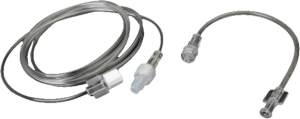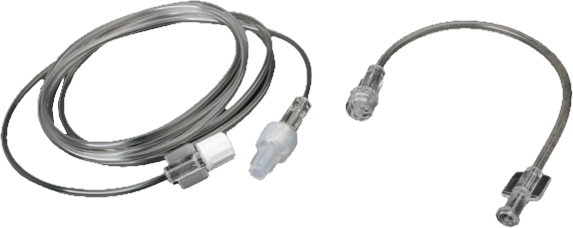As a leading all types of Medical Device Manufacturers, Nexgen Medical offers Infusion Extension Line at wholesale price.


Infusion Extension Line
A 2-way infusion extension line is a medical device that is used to connect an IV catheter to a source of fluid.
| Ref. No.: | ID.: | Length: |
|---|---|---|
| NMH040304 | 3.0 mm | 1.5m |
| NMH040308 | 1.7 mm | 1.5m |
A 2-way infusion extension line is a medical device that is used to connect an IV catheter to a source of fluid. The extension line allows the IV fluid to be infused into the patient at a controlled rate. The extension line also allows for the withdrawal of blood or other fluids from the patient. 2-way infusion extension lines are made from a variety of materials, including polyurethane, polyethylene, and PVC. The material selected for the extension line depends on the intended use of the device. For example, polyurethane is often used for devices that will be used for long-term infusion, while PVC is often used for devices that will be used for short-term infusion. 2-way infusion extension lines typically have two ports: a proximal port and a distal port. The proximal port is connected to the IV catheter, while the distal port is connected to the source of fluid. The proximal port has a valve that controls the flow of fluid into the patient. The distal port has a valve that controls the flow of fluid out of the patient. 2-way infusion extension lines are available in a variety of lengths. The length of the extension line should be selected based on the needs of the patient. For example, shorter extension lines may be used for patients who are able to move around easily, while longer extension lines may be needed for patients who are bedridden.
An infusion extension line is a medical device that is used to connect an intravenous (IV) catheter to a primary infusion line. Extension lines are available in a variety of lengths and sizes, and are typically made of flexible, non-reactive materials such as polyurethane or polyvinyl chloride. Infusion extension lines are sterile, single-use devices that are typically disposable after a single use. Extension lines are used when it is necessary to extend the length of an IV catheter beyond its initial placement site. They may also be used to connect two IV catheters together, or to connect an IV catheter to a secondary infusion line. Extension lines typically have male Luer-lock connectors on each end, which allow them to be securely attached to other medical devices. Most extension lines also have an internal valve that helps to prevent backflow of fluids.
An extension line is a tube that connects an infusion pump to a catheter. It is used to infuse medications, fluids, or nutrients into the body. The extension line allows the pump to be placed in a convenient location, such as on a belt or in a pocket, and the catheter can be placed at the infusion site.
If you are receiving intravenous (IV) therapy, chances are you will need to use an extension line. An extension line is a length of tubing that connects the primary IV line to the patient's vein. There are many different types of extension lines available, but the 2-way infusion extension line is one of the most commonly used. The 2-way infusion extension line has many benefits over other types of extension lines. One benefit is that it allows for more flexibility in IV placement. With a 2-way infusion extension line, the IV can be placed in any vein, regardless of its location. This is especially helpful for patients who have difficult veins or those who require multiple IVs. Another benefit of the 2-way infusion extension line is that it can be used with any type of catheter. This means that you can use the same extension line for both your primary and secondary IVs. This is extremely helpful if you need to receive IV therapy on a regular basis or if you have multiple sclerosis and require daily treatments. Finally, the 2-way infusion extension line is much easier to use than other types of extension lines. It is simple to connect and disconnect, and there is no need for special adapters or clamps. This makes it an ideal choice for both home care and hospital settings.
A 2-way infusion extension line is a type of medical device that is used to connect an IV catheter to a source of infusate. The extension line allows for the infusion of fluids into the patient's body and also allows for the withdrawal of blood or other fluids from the patient. There are two types of 2-way infusion extension lines: those with a luer lock connection and those with a Luer slip connection. The luer lock connection is the most common type of connection and is used with all types of IV catheters. The Luer slip connection is less common and is typically only used with certain types of IV catheters, such as those used for hemodialysis. 2-way infusion extension lines are available in various lengths, depending on the needs of the patient. They are also available in different sizes, which are determined by the inner diameter of the tubing. The most common size is 14 gauge, but other sizes are available as well. 2-way infusion extension lines are typically made from medical grade PVC or polyurethane and are sterile when they are packaged. They can be used with all types of IV solutions, including saline, dextrose, and lipid emulsions.